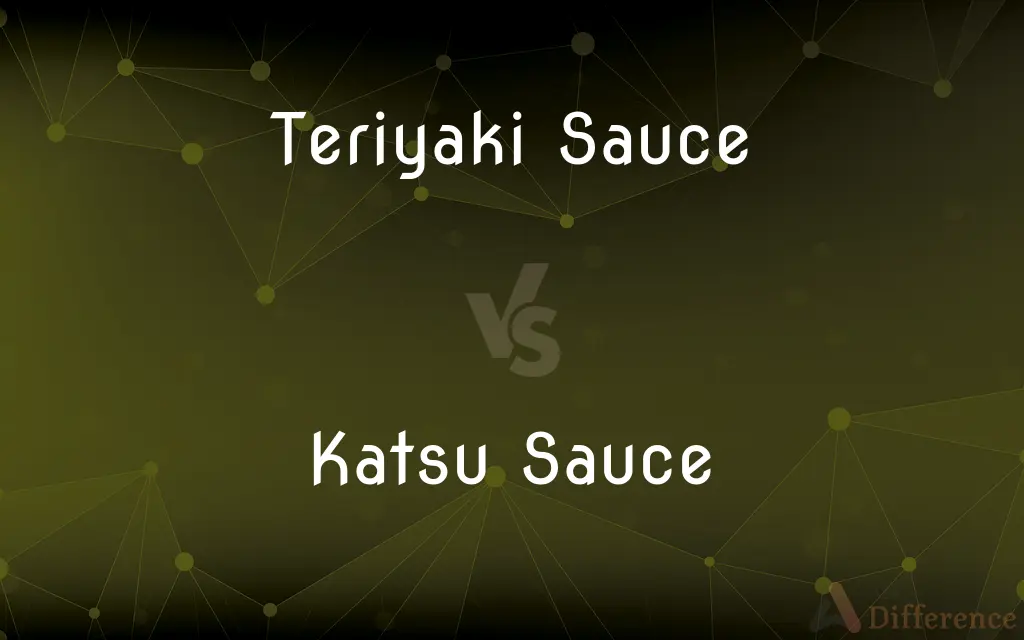Teriyaki Sauce vs. Katsu Sauce — What's the Difference?
By Tayyaba Rehman — Published on December 6, 2023
Teriyaki Sauce is a sweet and savory soy-based marinade, while Katsu Sauce is a tangy, fruit-based condiment often paired with breaded meats.

Difference Between Teriyaki Sauce and Katsu Sauce
Table of Contents
ADVERTISEMENT
Key Differences
Teriyaki Sauce is a classic Japanese sauce known for its perfect balance of sweet, salty, and savory flavors. It primarily consists of soy sauce, sake, mirin, and sugar. Katsu Sauce, on the other hand, is a Japanese condiment that's more akin to a tangy, spiced fruit purée. It complements dishes like Tonkatsu, a breaded and fried pork cutlet.
In terms of ingredients, Teriyaki Sauce employs the simplicity and depth of soy sauce, complemented by the sweetness of mirin or sugar. Katsu Sauce, however, is made with a base of pureed fruit, which can include apples, plums, or tomatoes, and is seasoned with various spices, sugar, and vinegar, giving it a unique tangy taste.
The consistency of Teriyaki Sauce is generally thicker, making it ideal as a glaze for grilling meats or vegetables. Its lustrous sheen gives dishes an appetizing look. Katsu Sauce, by contrast, is slightly thinner and is often used as a dipping sauce, particularly for breaded and fried foods, providing them with an added layer of flavor.
Functionally, Teriyaki Sauce can be both a marinade and a glaze, used in a variety of dishes, from chicken to fish. Its versatility is renowned in Japanese cuisine. Katsu Sauce, while specialized, is indispensable for Tonkatsu and other breaded foods, acting as a palate cleanser and flavor enhancer.
Culturally, while both sauces have their roots in Japan, Teriyaki Sauce has gained significant global popularity, being incorporated in various international dishes. Katsu Sauce remains more traditional, typically accompanying specific Japanese dishes.
ADVERTISEMENT
Comparison Chart
Base Ingredient
Soy sauce
Pureed fruit (e.g., apples, tomatoes)
Flavor
Sweet, salty, and savory
Tangy and spiced
Consistency
Thicker
Slightly thinner
Typical Use
Marinade and glaze for various dishes
Dipping sauce for breaded meats
Global Popularity
Widely recognized and used internationally
Primarily used in traditional Japanese cuisine
Compare with Definitions
Teriyaki Sauce
Teriyaki Sauce often acts as a glaze in grilled dishes.
The salmon was brushed with Teriyaki Sauce for a glossy finish.
Katsu Sauce
Katsu Sauce is a tangy, fruit-based Japanese condiment.
The pork cutlet was served with a side of Katsu Sauce.
Teriyaki Sauce
Teriyaki Sauce enhances meat, fish, and veggie dishes.
The Teriyaki Sauce gave the stir-fry an extra layer of depth.
Katsu Sauce
Katsu Sauce's consistency is perfect for dipping.
She enjoyed dipping her breaded shrimp into the Katsu Sauce.
Teriyaki Sauce
Teriyaki Sauce has roots in Japanese cuisine but is globally loved.
Many American grill recipes now include Teriyaki Sauce.
Katsu Sauce
Katsu Sauce traditionally enhances certain Japanese dishes.
No Tonkatsu dish is complete without Katsu Sauce on the side.
Teriyaki Sauce
Teriyaki Sauce is a soy-based Japanese marinade.
The chicken was marinated in Teriyaki Sauce, giving it a rich flavor.
Katsu Sauce
Katsu Sauce has a unique blend of fruitiness and spices.
The tangy nature of Katsu Sauce cuts through the richness of fried foods.
Teriyaki Sauce
Teriyaki Sauce combines sweet and savory elements.
Teriyaki Sauce is known for its delightful interplay of sugar and soy.
Katsu Sauce
Katsu Sauce often accompanies breaded and fried dishes.
Katsu Sauce is the preferred dip for Tonkatsu.
Common Curiosities
Can I use Teriyaki Sauce as a dipping sauce?
Yes, while Teriyaki Sauce can be a marinade or glaze, it's also used as a dip.
What dish is Katsu Sauce typically paired with?
Katsu Sauce is often paired with Tonkatsu, a breaded pork cutlet.
What gives Katsu Sauce its tanginess?
The blend of pureed fruit, vinegar, and spices in Katsu Sauce imparts tanginess.
Is Teriyaki Sauce always sweet?
While traditional Teriyaki Sauce is sweet, variations can adjust the sweetness level.
Can I use Katsu Sauce in a marinade?
While not traditional, Katsu Sauce can be used as a marinade for a unique flavor profile.
What is the main ingredient in Teriyaki Sauce?
Soy sauce is the primary ingredient in Teriyaki Sauce.
What's the difference in the consistency of Teriyaki Sauce and Katsu Sauce?
Teriyaki Sauce is generally thicker, while Katsu Sauce is slightly thinner.
Is Teriyaki Sauce popular outside Japan?
Yes, Teriyaki Sauce has gained significant popularity in various international cuisines.
Are there any substitutes for Katsu Sauce?
While unique, Worcestershire sauce mixed with ketchup and sugar can mimic Katsu Sauce's flavor.
What are the main ingredients in Katsu Sauce?
Katsu Sauce typically contains pureed fruit, spices, sugar, and vinegar.
Can I make homemade Teriyaki Sauce?
Yes, with soy sauce, mirin, sake, and sugar, you can make Teriyaki Sauce at home.
How long can I store Teriyaki Sauce in the refrigerator?
Sealed, Teriyaki Sauce can last for several weeks in the fridge.
How spicy is Katsu Sauce?
Katsu Sauce has a mild spice, but its primary flavor is tangy.
Where did Katsu Sauce originate?
Katsu Sauce originated in Japan and is deeply rooted in its culinary tradition.
Can I use Teriyaki Sauce on seafood?
Absolutely! Teriyaki Sauce complements various seafood, especially salmon.
Share Your Discovery

Previous Comparison
Duties vs. Responsibilities
Next Comparison
Banker’s Cheque vs. Demand DraftAuthor Spotlight
Written by
Tayyaba RehmanTayyaba Rehman is a distinguished writer, currently serving as a primary contributor to askdifference.com. As a researcher in semantics and etymology, Tayyaba's passion for the complexity of languages and their distinctions has found a perfect home on the platform. Tayyaba delves into the intricacies of language, distinguishing between commonly confused words and phrases, thereby providing clarity for readers worldwide.
















































